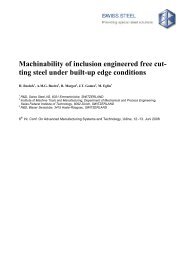Application of Thermodynamic Model for Inclusion Control in ...
Application of Thermodynamic Model for Inclusion Control in ...
Application of Thermodynamic Model for Inclusion Control in ...
Create successful ePaper yourself
Turn your PDF publications into a flip-book with our unique Google optimized e-Paper software.
comparison to exogenous <strong>in</strong>clusions the s<strong>of</strong>ten<strong>in</strong>g po<strong>in</strong>t <strong>of</strong><br />
glassy <strong>in</strong>digenous <strong>in</strong>clusions can be considerably lower.<br />
Thus if both exogenous and <strong>in</strong>digenous <strong>in</strong>clusions are eng<strong>in</strong>eered<br />
<strong>in</strong>to steels, the range <strong>of</strong> lubrication is enlarged and<br />
extended to lower cutt<strong>in</strong>g speeds. In the present work, the<br />
target <strong>in</strong>clusions are <strong>of</strong> pseudo-wollastonite type (exogenous)<br />
and <strong>of</strong> rhodonite/tephroite type (<strong>in</strong>digenous).<br />
In order to get the target oxide <strong>in</strong>clusions dur<strong>in</strong>g steel<br />
mak<strong>in</strong>g, the residual concentration <strong>of</strong> strong elements like<br />
Al <strong>in</strong> the melt must be controlled with<strong>in</strong> narrow w<strong>in</strong>dows<br />
<strong>for</strong> which slag-metal equilibration is the key. The three essential<br />
steps <strong>for</strong> <strong>in</strong>clusion control are:<br />
– slag-melt equilibration to control the residual concentration<br />
<strong>of</strong> reactive elements <strong>in</strong> the melt, such as the soluble<br />
alum<strong>in</strong>ium and the soluble oxygen,<br />
– calcium treatment to modify the exist<strong>in</strong>g exogenous oxide<br />
<strong>in</strong>clusion <strong>in</strong> the melt to a target glassy oxide <strong>in</strong>clusions,<br />
and<br />
– the control <strong>of</strong> the melt chemistry to <strong>for</strong>m <strong>in</strong>digenous oxide<br />
<strong>in</strong>clusions dur<strong>in</strong>g solidification <strong>of</strong> the melt <strong>in</strong> caster.<br />
S<strong>in</strong>ce the control <strong>of</strong> the target slag composition <strong>in</strong> the ladle<br />
ref<strong>in</strong><strong>in</strong>g furnace (LMF) is dependent upon upstream<br />
process control <strong>in</strong>volv<strong>in</strong>g m<strong>in</strong>imal carry-over furnace slag<br />
and reproducible recovery <strong>of</strong> deoxidants dur<strong>in</strong>g primary deoxidation,<br />
a clean steel practice is a prerequisite <strong>for</strong> slagmetal<br />
equilibration. In order to per<strong>for</strong>m the above steps under<br />
<strong>in</strong>dustrial production conditions, a thermodynamic<br />
model was developed to predict the exogenous and <strong>in</strong>digenous<br />
oxide <strong>in</strong>clusions onl<strong>in</strong>e, and to assist steel makers to<br />
control the composition <strong>of</strong> <strong>in</strong>clusions with<strong>in</strong> narrow tolerances.<br />
A detailed knowledge <strong>of</strong> elements and compound activities<br />
<strong>in</strong> the molten steel and <strong>in</strong> the slag is essential <strong>for</strong> the<br />
application <strong>of</strong> a thermodynamic<br />
model to improve the mach<strong>in</strong>ability<br />
<strong>of</strong> LCFCS through control the rhe-<br />
ology and composition <strong>of</strong> exogenous<br />
and <strong>in</strong>digenous oxide <strong>in</strong>clusions<br />
dur<strong>in</strong>g steel mak<strong>in</strong>g.<br />
This paper outl<strong>in</strong>es a thermodynamic<br />
model to evaluate the component<br />
activities <strong>in</strong> a multi-component<br />
system based on a sub-regular<br />
solution model [8] and its application<br />
<strong>for</strong> control <strong>of</strong> deoxidation<br />
process, slag-melt equilibration and<br />
melt-oxide <strong>in</strong>clusion equilibration<br />
to obta<strong>in</strong> the target glassy oxide <strong>in</strong>clusions<br />
<strong>in</strong> the melt. The <strong>in</strong>dustrial<br />
results show that thermodynamic<br />
modell<strong>in</strong>g is a powerful tool to produce<br />
<strong>in</strong>clusion eng<strong>in</strong>eered steel<br />
with consistently good mach<strong>in</strong>ability<br />
<strong>of</strong> LCFCS.<br />
<strong>Thermodynamic</strong> model<br />
Chemical reactions. In this approach,<br />
the chemical reactions underly<strong>in</strong>g<br />
the deoxidation <strong>of</strong> the<br />
melt, slag-melt equilibration, and<br />
Chemical reactions<br />
melt-oxide <strong>in</strong>clusion equilibration are considered. The deoxidation<br />
reaction occurr<strong>in</strong>g <strong>in</strong> the melt can be expressed as<br />
follows:<br />
x M + y O = MxOy(s) (1)<br />
where M (M = Al, Si, Mn and Ca) is the dissolved deoxidis<strong>in</strong>g<br />
element and O is the soluble oxygen <strong>in</strong> the melt, respectively.<br />
MxOy is an oxide product from the reaction<br />
(equation (1)), which is <strong>in</strong> the solid state; x and y are stoichiometric<br />
coefficients.<br />
The equilibrium constant <strong>of</strong> the reaction can be expressed<br />
as<br />
K M−O = aMx Oy<br />
ax y<br />
Ma O<br />
<strong>in</strong> which, �G o M−O<br />
Process Metallurgy – Steelmak<strong>in</strong>g<br />
= exp(− �Go M−O<br />
) (2)<br />
RT<br />
is the mole free energy change <strong>of</strong> the<br />
above deoxidization reaction (equation (1)) <strong>in</strong> the standard<br />
state, R is the gas constant, and T is temperature <strong>in</strong> K. aMx Oy<br />
is the activity <strong>of</strong> MxOy <strong>in</strong> the oxide system referred to pure<br />
solid standard state. aM and ao are the activities <strong>of</strong> M and O<br />
<strong>in</strong> the melt referenced to 1 weight % solution <strong>in</strong> iron, respectively.<br />
Table 1 gives the chemical reactions tak<strong>in</strong>g place <strong>in</strong> deoxidation<br />
<strong>of</strong> the melt, <strong>in</strong> slag-melt equilibration and <strong>in</strong> meltoxide<br />
<strong>in</strong>clusion equilibrium dur<strong>in</strong>g steel mak<strong>in</strong>g, and their<br />
mole free energy changes <strong>in</strong> standard state, as well as their<br />
reaction constants. The chemical free energy <strong>for</strong> the deoxidation<br />
reactions by silicon, alum<strong>in</strong>ium, calcium and man-<br />
Table 1. <strong>Thermodynamic</strong> data on chemical reactions tak<strong>in</strong>g place <strong>in</strong> deoxidation, slag-metal<br />
equilibration, melt-oxide equilibrium.<br />
Mole free energy<br />
changes<br />
0<br />
∆G (J/mol)<br />
M−O Constants, KM-O<br />
0 [=exp(- ∆GM−O/RT)] Si + 2O = SiO2(s) -594230 + 229.73 T [7] aSiO2<br />
2<br />
aSiaO 2Al + 3O = Al2O3(s) -1201860 + 323.22 T [7] a Al2O3 2 3<br />
aAlaO Ca + O = CaO(s) -491140 + 146.45 T [8] aCaO<br />
aCaaO Mn + O = MnO(s) -288120 + 128.26 T [7]<br />
2/3Al2O3(s) + Si = SiO2(s) + 4/3Al 207010 - 32.42 T<br />
SiO2(s) +2Ca = 2CaO(s) + Si 388050 – 63.17 T<br />
SiO2(s) +2Mn = 2MnO(s) + Si -17990 + 26.79 T<br />
steel research <strong>in</strong>t. 75 (2004) No. 5 315<br />
a MnO<br />
a a<br />
Mn O<br />
43 /<br />
a a<br />
/<br />
a a<br />
Al SiO2<br />
23<br />
Si Al2O3 2<br />
aSiaCaO<br />
2<br />
aCaaSiO2<br />
2<br />
aSiaMnO<br />
2<br />
aMnaSiO2










